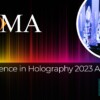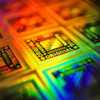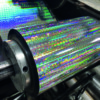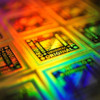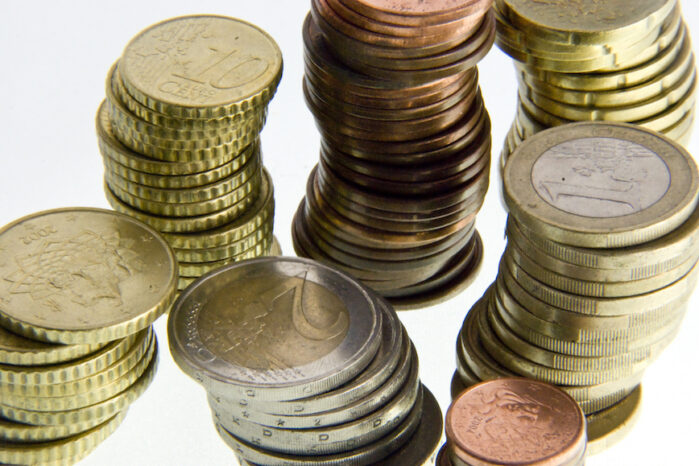
Holograms Continue to Coin It!
19 Oct 2022 | Press Release
Across the world, mints continue to recognise the eye-catching appeal of holograms for their commemorative coin programmes for the collectors’ market, says Dr Paul Dunn, chair of the International Hologram Manufacturers Association.
The application of holograms on commemorative coins, which are issued to mark special events, started in the early 1990s. They are mainly added for eye-catching decoration and to generate interest amongst the numismatists, although in a separate application, cryptocurrencies are now using holograms as labels to protect security codes. Today, the global coin collectors (numismatics) market is estimated to be worth around US$17 billion in annual revenues, according to Mhojhos Research, and numbers a community of 615 billion people around the world.
Holograms are not dissimilar to the latent images which are used as a security feature on several high value circulating coins. They are also a composition of fine lines that are engraved into the coin die, and both show different effects according to the viewing angle. In the case of holograms, however, the effects are dependent on exceptionally small and precise microgrooves. When these microgrooves start degrading – as they are accustomed to do both in the minting process and when handled – so does the image. Hence holograms are not suitable for large volume production, nor high circulation use, even though they do offer an added level of security (they are widely used to protect banknotes and other high value documents). But they do have benefits for collectors’ coins and bullion products, in the latter offering a mark of authenticity along with visual appeal.
Using the latest techniques, it is possible to create holographic effects on top of engraved coin surfaces. In this way, the hologram doesn’t necessarily occupy the entire coin surface but only a certain part of it in order to enhance the overall design. Few mints are able to produce holographic coins all by themselves. Those that do not yet possess the necessary expertise and technology work with partners in the optical industry. One such company, Optaglio, was instrumental in creating the first ever holographic coin: a silver coin with a gold insertion of nominal value 2000 CZK, issued by the Czech National Bank. Since then, Optaglio has been active in this area and developed significant experience with printing holograms onto different metals.
Of course, adding a hologram to a coin means that it is acting as a security device even if that is not its main purpose. But there is another interesting aspect of including a hologram – it is possible to have animated images on coins. The first example was the 5-Diners Beatification of John Paul II silver hologram coin released in Andorra in 201, only six years after his death. The silver coin shows the former head of the catholic church at his papal blessing in a striking hologram – in the right light reflection, the Pope’s familiar movement of the hand appears.
Growth in popularity
The popularity of holographic coins has increased significantly in recent times. Indeed, to such a point that a number of mints around the world now produce coins to the highest technical and quality standards.
These can be divided into both privately held mints like Pobjoy (UK), Merrick (US) and national, mainly government-owned mints in Canada, Australia, Poland, Czech Republic, Croatia and Singapore. However, dividing lines can blur and frequently the public and private sector intersect. A typical example is in Eastern Europe where Czech company Metallic Security s.r.o. offers technology and origination services to state mints. In North America, the Royal Canadian Mint is at the forefront of pioneering hologram coins, undoubtedly minting some of the most eye-catching and interesting coins ever produced. Across the border, the USA continues to produce hologram coins, although these are not authorised by the US Mint and therefore are not legal tender.
In 2004, the Royal Australian Mint included for the first time a holographic coin in its Proof Year Set. The five kangaroos on the A$1 coin appear as multi-coloured, iridescent holograms, conveying the impression of colour and movement. Considered to be a world first at the time and a return to the original designs of its circulating decimal currency, the hologram was achieved using a manufacturing method – developed by the CSIRO in conjunction with the Mint – called Replica Micro Moulding. This uses a high precision elastomer stamp as a means for transferring a complex micro-pattern (the holographic image) onto the surface of the coin. A finely focused electron beam forms a pattern of fine grooves (which is the image that will appear on the reverse of the coin) on a specially prepared elastomer stamp.
After striking the coin with the obverse image (an effigy of the Queen) in the normal way in a coining press, the coin then goes through a second process where it has a resin application and is struck using the stamp. The fine pattern of grooves applied to the surface of the coin has been specifically designed to give an iridescent image with distinct colours and featuring a movement of the image with tilting of the coin. Thus, it appears that the hologram is not embossed directly into the metal of the coin but into a layer of resin coated on one blank side after the reverse side has already been struck in the conventional way.
A more recent holographic coin from Australia was the Aurora Australis silver coin struck from 99.9% pure silver – the fourth in the Royal Australian Mint’s International Polar Year series. More than 12,000 coins were struck which included, in a hologram form, a map of Antarctic scientific bases, a Skua and the first Australians to reach the South Magnetic Pole.
Global use
Other noteworthy commemorative holographic coins include a non-circulating series entitled ‘Mysteries of the World’ issued by the Pacific Ocean commonwealth of the Northern Mariana Islands, which featured a coin with holographic images of crop circles.
Also, in the Asia-Pacific region, the official issuer of New Zealand commemorative coins, the New Zealand Post’s animated Southern Sky $1 hologram coin (issued 2017) had an effigy of HM Queen Elizabeth II, which when tilted, shows a hologram: the dancing and shimmering light of the Southern Lights. Utilising a holographic foiling technique, this image aims to capture the ethereal look of the aurora. An 8,500 minted animated Northern Lights $20 hologram coin was issued in 2015 by the Royal Canadian Mint with an obverse portrait of Queen Elizabeth II and a reverse hologram which, when tilted, shows a soaring raven against an eye-catching holographic Northern Lights’ lit sky, reminiscent of the ever-changing Aurora Borealis.
The Czech Republic’s 500 Kč Škoda 498 steam locomotive hologram coin is another example of eye-catching innovation within a niche sector – a steam locomotive hologram when tilted displays many different colourful images. In 2022, the Czech Mint issued the Czech Lion silver 240 NZD hologram coin produced by the Czech company IQ Structures.
This features an embedded hologram in the shape of a shield placed on the bottom of the reverse side of the coin, which is dominated by the Czech Lion in an untraditionally realistic presentation with the St. Wenceslas Crown on its head. When illuminated at a certain angle, a hidden ‘moving’ figure appears in the shield. The obverse side then bears an eagle on a shield, which is a synthesis of St. Wenceslas, Moravian and Silesian predators.
Crypto-currencies and holograms
As noted above, in addition to commemorative coins for the collectors’ market, holograms are also finding new uses to secure crypto currencies.
Not only do crypto currencies exist but also crypto states. The 2022 Liberty United Crypto States 1000 Satoshi silver hologram coin issued by the United Crypto States (UCS) is the first one from the UCS series. Combining the history of silver and cutting-edge hologram technology, Liberty is presented in the form of a classic coin. As a so-called legal tender of the United Crypto States – a virtual state based on a community of collectors – it is denominated in Bitcoin, the current king of the cryptocurrency universe. There is a hologram, created to protect against counterfeiting, together with a QR code with a 1000 Satoshi denomination.
As this shows, even if cryptocurrency is digital, the physical counterparts exist – both in metal and paper form, and the move from digital to paper-based crypto currencies is creating further opportunities for holography.
In the case of physical bitcoin ‘coins’, these have their own bitcoin address and a redeemable ‘private key’ printed on a card that is embedded inside the coin and covered up or protected by tamper-proof hologram applied to the surface.
And then there are paper-based cryptocurrencies, also known as hybrid banknotes, which resemble traditional banknotes but with the facility to have funds loaded onto them which can then be used to pay for goods or services at outlets which accept them. Or simply to store value.
In this world, holographic technology is helping to provide authentication in the form of the Icynote brand from SMD Security Printing Sarl. This wallet, which works with any business or trade that accepts crypto currencies as a form of payment, allows the ‘banknote’ to receive funds directly from its customers. The buyer only has to scan the QR code and send the this to the seller to complete the transaction.
The Bitcoin Suisse Crypto ‘banknote’ is another development that sees a paper wallet that holds a public address key accessed by a QR code and a private key that is concealed by multiple security features. It has the ‘look and feel’ of a traditional banknote and includes a unique ‘Nanocrypt’ hologram alongside other security features, which incorporates the company name and logo, nano-optical structures, microtext, a decorative effect known as guilloche and spectral line patterns among other strong visual effects.
Looking to the future
What about future developments? We can see that there are reasons why holograms should migrate onto coins in circulation but the main one has to be security. Just as holograms, or more correctly, optically variable security devices have found widespread acclaim as banknote security features, helping to protect against counterfeiting, they could offer the same function on coins.
This comes at a time of growing incidences of counterfeit coin seizures. According to the European Commission, the volume of counterfeit euro coins increased by 6.35% in 2019 (the last year figures were published). The greatest increase was in counterfeit €2 coins (15%), which comprised 93% of the total (the EC only analyses and reports on €1 and €2 and 50 euro cent coins). For commemorative euro coins (which are always €2 coins), the increase in counterfeit detected in 2019 was 20%. This summer, the Irish Garda issued a warning over fake €2 coins following the seizure of counterfeit currency in Dublin.
Elsewhere, law enforcement authorities in the USA seized more than 40,000 fake Morgan and Peace dollars, American Eagle silver bullion coins and $2 ½ Indian Head gold coins 2021 while the introduction of a new £1 coin in the UK in 2017 was down to the fact that, by then, almost 3% of the old £1 coins in circulation were fake. The financial incentive to find an effective deterrent is potent – and should mints be able to develop the technology to produce effective circulating coins displaying holographic effects that withstand the rigours of use, then the opportunities for a new line of use for holography are considerable.







